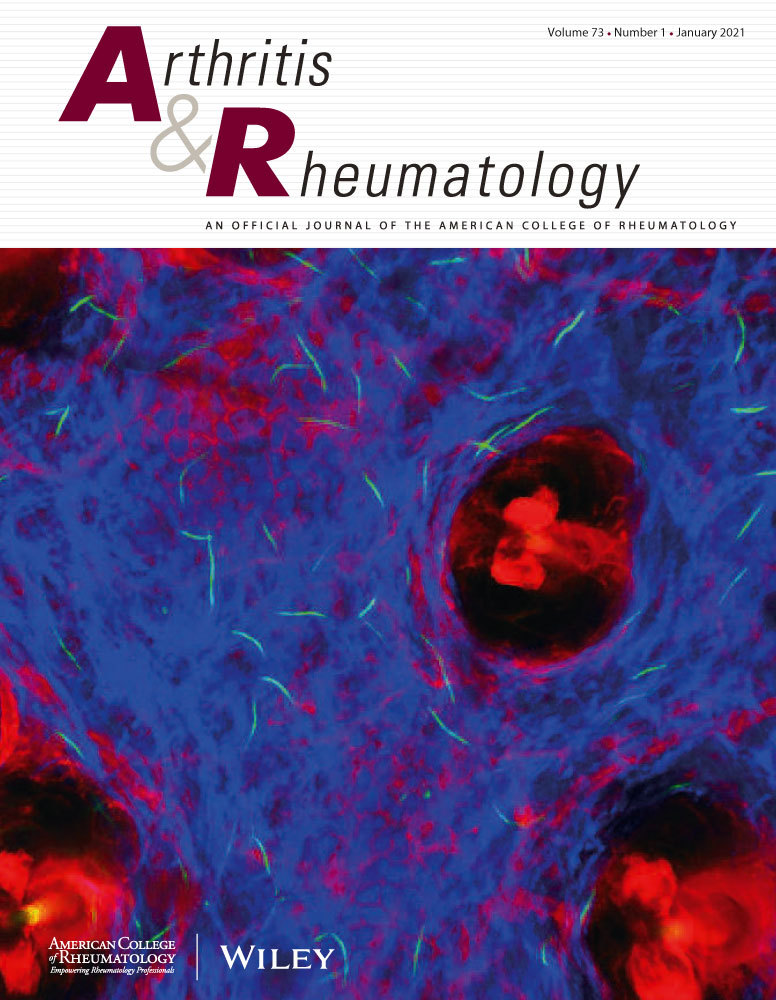系统性硬化症患者左室收缩功能不全的危险因素及心脏恢复的预测因素。
IF 10.9
1区 医学
Q1 RHEUMATOLOGY
引用次数: 0
摘要
背景:系统性硬化症(SSc)的心脏受累是导致死亡的主要原因。我们试图研究SSc左心室收缩功能障碍(LVSD)和心脏恢复的预测因素。方法对约翰霍普金斯硬皮病研究中心登记的2303例患者和13209例超声心动图进行分析。通过拟合具有时变和不变变量的多变量logistic回归模型,我们确定了与左心室射血分数(EF)状态转变(EF≥50%下降到35%下降到≤35%[严重LVSD])相关的预测因素。使用随机森林分析中确定的重要变量,通过拟合多变量逻辑回归模型确定与心脏恢复相关的变量。结果:小性别、黑人、弥漫性皮肤病、较高的mRSS、肺动脉高压(PH)、肾脏疾病和心房颤动(AFib)的超声心动图证据与LVSD发生率增加(EF35%)相关。结论:不同的人口统计学、SSc特异性和心脏特征与SSc发生LVSD的风险增加有关,骨骼肌病和抗ku抗体是严重疾病的重要危险因素。一些患者病情好转,这在抗polr3阳性患者中更有可能发生。本文章由计算机程序翻译,如有差异,请以英文原文为准。
Identification of risk factors for incident left ventricular systolic dysfunction and predictors of cardiac recovery in patients with systemic sclerosis.
BACKGROUND
Cardiac involvement in systemic sclerosis (SSc) is a leading cause of death. We sought to investigate predictors of incident left ventricular systolic dysfunction (LVSD) and cardiac recovery in SSc.
METHODS
2,303 patients in the Johns Hopkins Scleroderma Center Research Registry and 13,209 echocardiograms were analyzed. We identified predictors associated with incident LVSD defined by transitions in left ventricular (LV) ejection fraction (EF) states (EF≥50% declining to <50% and EF>35% dropping to ≤35% [severe LVSD]) by fitting multivariate logistic regression models with time-varying and invariant variables. Variables associated with cardiac recovery were identified by fitting multivariate logistic regression models using important variables identified from random forest analysis.
RESULTS
Male sex, Black race, diffuse skin disease, higher mRSS, echocardiographic evidence of pulmonary hypertension (PH), kidney disease, and atrial fibrillation (AFib) were associated with increased odds of incident LVSD (EF<50%), while anti-centromere and anti-topoisomerase-1 were protective. Male sex, higher mRSS, PH, skeletal myopathy, kidney disease, AFib, and anti-Ku antibodies were associated with higher odds of incident severe LVSD (EF≤35%). For previous EF<50%, tendon friction rubs were associated with lower odds of cardiac recovery, and anti-RNA polymerase III (POLR3) with higher odds. For previous EF≤35%, diabetes was associated with lower odds of recovering to EF>35%.
CONCLUSIONS
Distinct demographic, SSc-specific and cardiac characteristics associate with increased risk of incident LVSD in SSc, with skeletal myopathy and anti-Ku antibodies being important risk factors for severe disease. Some patients improve, which is more likely in anti-POLR3-positive patients.
求助全文
通过发布文献求助,成功后即可免费获取论文全文。
去求助
来源期刊

Arthritis & Rheumatology
RHEUMATOLOGY-
CiteScore
20.90
自引率
3.00%
发文量
371
期刊介绍:
Arthritis & Rheumatology is the official journal of the American College of Rheumatology and focuses on the natural history, pathophysiology, treatment, and outcome of rheumatic diseases. It is a peer-reviewed publication that aims to provide the highest quality basic and clinical research in this field. The journal covers a wide range of investigative areas and also includes review articles, editorials, and educational material for researchers and clinicians. Being recognized as a leading research journal in rheumatology, Arthritis & Rheumatology serves the global community of rheumatology investigators and clinicians.
 求助内容:
求助内容: 应助结果提醒方式:
应助结果提醒方式:


